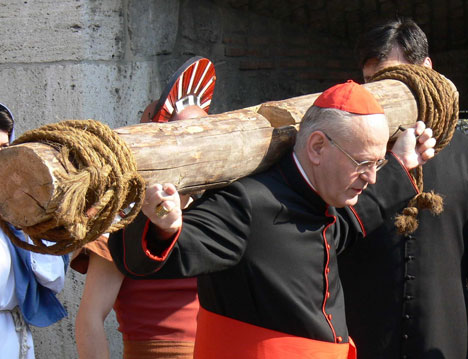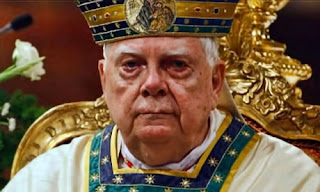- Get link
- X
- Other Apps
Popular Posts
Erotic Church Service- More Sex for the Vicar
- Get link
- X
- Other Apps
World's youngest Cardinal equates faithful homosexual and heterosexual relations
- Get link
- X
- Other Apps
Bishop resigns after clashing with his diocese over Latin Mass
- Get link
- X
- Other Apps
Cardinal Martini speaks to the Church from beyond the grave- full text
- Get link
- X
- Other Apps
Top German paediatrician finds outcome of Alfie Evans case completely incomprehensible
- Get link
- X
- Other Apps
Francis wants to erase all trace of Pope Benedict. The Damnatio Memoriae continues.
- Get link
- X
- Other Apps










.jpeg)
Comments
Not Take this* all of you and eat it.
(*But only on the mouth because only the apostles were worthy to take the bread and eat it with their hands).
Receiving the Eucharist on our hands shows many things;
1)Not only do we receive Christ on our tongue (our words), we receive him into our hands (actions)
2)We consciously choose to accept Christ into our lives, by taking Him with our own hands.
3)Christ definately did not take take the first Eucharist and put it into the Apostles' mouths.
4)In the early days of the Church the faithful frequently carried the Blessed Eucharist with them to their homes (cf. Tertullian, "Ad uxor.", II, v; Cyprian, "De lapsis", xxvi) or upon long journeys (Ambrose, De excessu fratris, I, 43, 46), while the deacons were accustomed to take the Blessed Sacrament to those who did not attend Divine service (cf. Justin, Apol., I, n. 67), as well as to the martyrs, the incarcerated, and the infirm (cf. Eusebius, Hist. Eccl., VI, xliv). The deacons were also obliged to transfer the particles that remained to specially prepared repositories called Pastophoria (cf. Apostolic Constitutions, VIII, xiii).
5)The word paten comes from a Latin form patina or patena, evidently imitated from the Greek patane. It seems from the beginning to have been used to denote a flat open vessel of the nature of a plate or dish. Such vessels in the first centuries were used in the service of the altar, and probably served to collect the offerings of bread made by the faithful and also to distribute the consecrated fragments which, after the loaf had been broken by the celebrant, were brought down to the communicants, WHO IN THEIR OWN HANDS RECEIVED EACH A PORTION FROM THE PATINA…
So according to St. Justin Martyr, Tertullian, St. Cyprian of Carthage, St. Cyril of Jerusalem, St. Ambrose of Milan, St. Basil the Great, the Synod of Trullo, St. John Damascus, and the Catholic Encyclopedia, communion by hand was not at all uncommon in the early Church. In fact, it was a recommended manner of reception in many places. Unless these Fathers and Doctors (and all but Tertullian are saints) were thus "sacrilegious" or promoting a "lessening of respect for the Eucharist."
Therefore Communion by hand was accepted in the first millennium. Nor for the most part was it considered irregular.
So in Vatican II receiving in the hands has more historical context then receiving on the tongue ever did, and therefore, it would be more conservative, and in line with the Church Fathers, to receive on the hands.
-Dominicae Cenae
And so you believe that there should be no Eucharistic ministers? In what context do you use ordained?
INAESTIMABILE DONUM—
Instruction Concerning Worship Of The Eucharistic Mystery
"The faithful, whether religious or lay, who are authorized as extraordinary ministers of the Eucharist can distribute Communion only when there is no priest, deacon or acolyte, when the priest is impeded by illness or advanced age, or when the number of the faithful going to Communion is so large as to make the celebration of Mass excessively long."
"11. The Church has always required from the faithful respect and reverence for the Eucharist at the moment of receiving it.
With regard to the manner of going to Communion, the faithful can receive it either kneeling or standing, in accordance with the norms laid down by the episcopal conference: "When the faithful communicate kneeling, no other sign of reverence towards the Blessed Sacrament is required, since kneeling is itself a sign of adoration. When they receive Communion standing, it is strongly recommended that, coming up in procession, they should make a sign of reverence before receiving the Sacrament. This should be done at the right time and place, so that the order of people going to and from Communion is not disrupted."[21]
The "Amen" said by the faithful when receiving Communion is an act of personal faith in the presence of Christ."
MEMORIALE DOMINI
Instruction on the Manner of Distributing Holy Communion
Sacred Congregation for Divine Worship
Issued on May 29, 1969.
"It is certainly true that ancient usage once allowed the faithful to take this divine food in their hands and to place it in their mouths themselves."
"5. No matter which method is adopted, one will be careful not to allow any fragment of the host to fall...."
And overall, it doesn't matter which way you receive, because you receive the same benefits from our Most Gracious Lord and Savior.
But, whether receiving on the hands, or on the tongue, there is always the possibility the the faithful still do not fully know what they are receiving, so instead of worrying over which way to receive the Lord, because both ways are proven viable, we should be trying to educate the faithful in what the Eucharist truly is.
Secretary of the Congregation for Divine Worship
Archbishop Ranjith on Kneeling for Communion during the liturgy and Communion on the Tongue, writing a foreword on the Book, "Dominus Est":
1) At the same time, speaking of communion in the hand, it must be recognized that the practice was improperly and quickly introduced in some quarters of the Church shortly after the Council, changing the age-old practice and becoming regular practice for the whole Church. They justified the change saying that it better reflected the Gospel or the ancient practice of the Church... Some, to justify this practice referred to the words of Jesus: "Take and eat" (Mk 14, 22; Mt 26, 26).
Now I think it is high time to review and re-evaluate such good practices and, if necessary, to abandon the current practice that was not called for by Sacrosanctum Concilium, nor by Fathers, but was only accepted after its illegitimate introduction in some countries.Now, more than ever, we must help the faithful to renew a deep faith in the Real Presence of Christ in the Eucharistic species in order to strengthen the life of the Church and defend it in the midst of dangerous distortions of the faith that this situation continues to cause.
2) I mention for example, a change not proposed by the Council Fathers or by the Sacrosanctum Concilium, Holy Communion received in the hand. This has contributed to some extent to a weakening of faith in the real presence of Christ in the Eucharist. This, and the removal of altar rails and kneelers in church and the introduction of practices which oblige the faithful to sit or stand at the elevation of the Sacred Host, weakens the genuine significance of the Eucharist and the Church's profound sense of adoration for the Lord, the Only Son of God. Moreover in many places, the church the 'house of God', is used for meetings, concerts or interreligious celebrations. In some churches the Blessed Sacrament is almost hidden away in a little chapel, hardly seen and little decorated. All this obscures a belief so central in the Church, belief in the real presence of Christ. The church, for Catholics, is the 'home' of the Eternal One.
Another serious mistake is to confuse specific roles of the clergy and the laity at the altar making the sanctuary a place of disorder, too much movement and certainly not the 'place' where the Christian is filled with a sense of wonder and awe in front of the Lord's presence and His act of redemption. The use of dancing, musical instruments and singing which have little to do with liturgy, is not in keeping with the sacredness of a church and liturgical celebrations; I would also add, certain homilies of a political-social character, often badly prepared. All this distorts the celebration of Mass, making it a choreographic, theatrical event, instead of an event of faith.
Hope this helps!
Again "MEMORIALE DOMINI
Instruction on the Manner of Distributing Holy Communion
Sacred Congregation for Divine Worship
Issued on May 29, 1969.
"It is certainly true that ancient usage once allowed the faithful to take this divine food in their hands and to place it in their mouths themselves."
"5. No matter which method is adopted, one will be careful not to allow any fragment of the host to fall....""
Our choir stands behind the priest during Mass, and you can choose to focus on them, or to focus on the Mass. Also, the Last Supper , though in a room, was filled with hustle and bustle, due to the Passover coming up, so historically...
Not that the Mass should be confusion, rather focused on the Holy Eucharist, but receiving in the hand was proposed by multiple different Church documents etc.
Pertaining to point number one, as stated above, even if hastily introduced, it is still something that was licitly proposed and completed. I have never received the Eucharist upon my tongue, and I see Christ in the Eucharist, not only see, but recognize, respect, and have "a deep faith in the Real Presence of Christ in the Eucharistic species...."
Pertaining to the kneelers and altar rails; few Churches, in the Archdiocese of Seattle, have removed kneelers, and many Churches still kneel at the consecration. However, standing or sitting at the consecration cannot be viewed as weakening "the genuine significance of the Eucharist" because many cultures (and age groups) either find it more respectful to stand (hence the reason why standing is common when someone highly respected, even the priest, enters the room), or it is physically impossible to kneel for some (think old-er people).
As for having a smaller "sub chapel" of sorts, I find it to be consoling because the Blessed Sacrament is then in an area where the Faithful can adequately adore him outside of Mass, and get 'up and personal' of sorts with Christ, while in older parishes it is still impossible because the Tabernacle is still behind the Altar, so either one stays 35-40 feet away, or the go upon the sanctuary to Adore Him.
As for the Tabernacle and "sub chapel" being sparsely decorated; is it really a sparseness of decoration, or beauty in simplicity? I, now, can think of more than one Parish in which the Tabernacle is kept in a "sub chapel" of sorts and has very few decorations, but the simplicity of the whole thing is more magnificence than some of the highest decorated Tabernacles I have ever laid eyes on.
Thank you for the ongoing discussion.